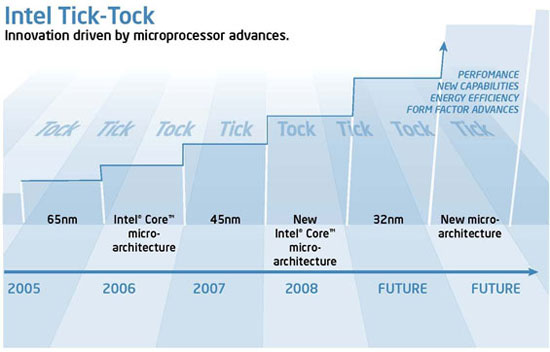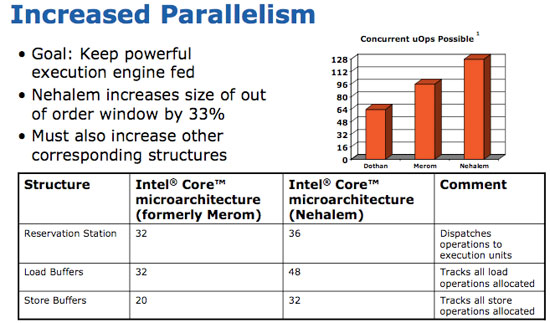The Dark Knight: Intel's Core i7
by Anand Lal Shimpi & Gary Key on November 3, 2008 12:00 AM EST- Posted in
- CPUs
Nehalem.
Nuh - hay - lem
At least that's how Intel PR pronounces it.
I've been racking my brain for the past month on how best to review this thing, what angle to take, it's tough. You see, with Conroe the approach was simple: the Pentium 4 was terrible, AMD proudly wore its crown and Intel came in and turned everyone's world upside down. With Nehalem, the world is fine, it doesn't need fixing. AMD's pricing is quite competitive, Intel's performance is solid, power consumption isn't getting out of control...things are nice.
But we've got that pesky tick-tock cadence and things have to change for the sake of change (or more accurately, technological advancement, I swear I'm not getting cynical in my old age):

2008, that's us, that's Nehalem.
Could Nehalem ever be good enough? It's the first tock after Conroe, that's like going on stage after the late Richard Pryor, it's not an enviable position to be in. Inevitably Nehalem won't have the same impact that Conroe did, but what could Intel possibly bring to the table that it hasn't already?
Let's go ahead and get started, this is going to be interesting...
Nehalem's Architecture - A Recap
I spent 15 pages and thousands of words explaining Intel's Nehalem architecture in detail already, but what I'm going to try and do now is summarize that in a page. If you want greater detail please consult the original article, but here are the cliff's notes.

Nehalem
Nehalem, as I've mentioned countless times before, is a "tock" processor in Intel's tick-tock cadence. That means it's a new microarchitecture but based on an existing manufacturing process, in this case 45nm.
A quad-core Nehalem is made up of 731M transistors, down from 820M in Yorkfield, the current quad-core Core 2s based on the Penryn microarchitecture. The die size has gone up however, from 214 mm^2 to 263 mm^2. That's fewer transistors but less densely packed ones, part of this is due to a reduction in cache size and part of it is due to a fundamental rearchitecting of the microprocessor.
Nehalem is Intel's first "native" quad-core design, meaning that all four cores are a part of one large, monolithic die. Each core has its own L1 and L2 caches, and all four sit behind a large 8MB L3 cache. The L1 cache remains unchanged from Penryn (the current 45nm Core 2 architecture), although it is slower at 4 cycles vs. 3. The L2 cache gets a little faster but also gets a lot smaller at 256KB per core, whereas the lowest end Penryns split 3MB of L2 among two cores. The L3 cache is a new addition and serves as a common pool that all four cores can access, which will really help in cache intensive multithreaded applications (such as those you'd encounter in a server). Nehalem also gets a three-channel, on-die DDR3 memory controller, if you haven't heard by now.

At the core level, everything gets deeper in Nehalem. The CPU is just as wide as before and the pipeline stages haven't changed, but the reservation station, load and store buffers and OoO scheduling window all got bigger. Peak execution power hasn't gone up, but Nehalem should be much more efficient at using its resources than any Core microarchitecture before it.

Once again to address the server space Nehalem increases the size of its TLBs and adds a new 2nd level unified TLB. Branch prediction is also improved, but primarily for database applications.
Hyper Threading is back in its typical 2-way fashion, so a single quad-core Nehalem can work on 8 threads at once. Here we have yet another example of Nehalem making more efficient use of the execution resources rather than simply throwing more transistors at the problem. With Penryn Intel hit nearly 1 billion transistors for a desktop quad-core chip, clearly Nehalem was an attempt to both address the server market and make more efficient use of those transistors before the next big jump and crossing the billion transistor mark.










73 Comments
View All Comments
Gary Key - Monday, November 3, 2008 - link
"The 920 to 3.6/3.8 is a nice overclock but I wonder what you mean by proper cooling and how close you came to crossing the 80C "boundary"?"It was actually quite easy to do with the retail cooler, in fact in our multi-task test playing back a BD title while encoding a BD title, the core temps hit 98C. Cinebench multi-core test and OCCT both had the core temps hit 100C at various points. Our tests were in a closed case loaded out with a couple of HD4870 cards, two optical drives, three hard drives, and two case fans.
Proper cooling (something we will cover shortly) consisted of the Thermalright Xtreme120, Vigor Monsoon II, and Cooler Master V8 along with the Freezone Elite. We were able to keep temps under 70C with a full load on air and around 45C with the Freezone unit.
Th3Eagle - Tuesday, November 4, 2008 - link
Wow, thats interesting. Can't wait to see the new article. Always nice to see an article about coolers.Thanks for the reply.
Anand Lal Shimpi - Monday, November 3, 2008 - link
Gary did the i7-920 tests so I'll let him chime in there, we're also working on an overclocking guide that should help address some of these concerns.-A
whatthehey - Monday, November 3, 2008 - link
Tom's? You might as well reference HardOCP....Okay, THG sometimes gets things right, but I've seen far too many "expose" articles where they talk about the end of the world to take them seriously. Ever since the i820 chipset fiasco, they seem to think everything is a big deal that needs a whistle blower.
Anandtech got 3.8GHz with an i7-920, and I would assume due diligence in performance testing (i.e. it's not just POSTing, but actually running benchmarks and showing a performance improvement). I'm still running an overclocked Q6600, though, and the 3.6GHz I've hit is really far more than I need most of the time. I should probalby run at 3.0GHz and shave 50-100W from my power use instead. But it's winter now, and with snow outside it's nice to have a little space heater by my feet!
The0ne - Monday, November 3, 2008 - link
TomHardware and Anandtech were the one websites I visited 13 years ago during my college years. Tom's has since been pushed far down the list of "to visit sites" mainly due to their poor articles and their ad littered, poorly designed website. If you have any type of no-script enable there's quite a bit to enable to have the website working. The video commentary is a joke as they're not professionals to get the job done professionally...visually anyhow.Anandtech has stayed true to it's root and although I find some articles a bit confusing I don't mind them at all. Example of this are camera reviews :)
GaryJohnson - Monday, November 3, 2008 - link
Geez, calling a core 2 a space heater. How soon we forget prescott...JarredWalton - Monday, November 3, 2008 - link
I think overclocked Core 2 Quad is still very capable of rating as a space heater. The chips can easily use upwards of 150W when overclocked, which if memory serves is far more than any of the Prescott chips did. After all, we didn't see 1000W PSUs back in the Prescott era, and in fact I had a 350W PSU running a Pentium D 920 at 3.4 GHz without any trouble. :-)Griswold - Tuesday, November 4, 2008 - link
Funny comparison. If it was just for the space heater arguments sake (well, 150W is by far not enough to qualify as a real space heater to be honest), I could follow you but saying the 150W of a 4 core, more-IPC-than-any-P4-can-ever-dream-of, processor should or could be compared to the wattage of the infamous thermonuclear furnace AKA prescott, is a bit of a long stretch, dont you think? :pRyan Smith - Monday, November 3, 2008 - link
Intel can call it supercalifragilisticexpialidocious until they're blue in the face, but take it from a local, it's Neh-Hay-Lem. Just see how it's pronounced in this news segment:http://www.katu.com/outdoors/3902731.html?video=YH...">http://www.katu.com/outdoors/3902731.html?video=YH...
mjrpes3 - Monday, November 3, 2008 - link
Any chance we'll see some database/apache benchmarks based on Nehalem soon?